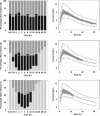Extensions to the visual predictive check to facilitate model performance evaluation
- PMID: 18197467
- PMCID: PMC2798054
- DOI: 10.1007/s10928-007-9081-1
Extensions to the visual predictive check to facilitate model performance evaluation
Abstract
The Visual Predictive Check (VPC) is a valuable and supportive instrument for evaluating model performance. However in its most commonly applied form, the method largely depends on a subjective comparison of the distribution of the simulated data with the observed data, without explicitly quantifying and relating the information in both. In recent adaptations to the VPC this drawback is taken into consideration by presenting the observed and predicted data as percentiles. In addition, in some of these adaptations the uncertainty in the predictions is represented visually. However, it is not assessed whether the expected random distribution of the observations around the predicted median trend is realised in relation to the number of observations. Moreover the influence of and the information residing in missing data at each time point is not taken into consideration. Therefore, in this investigation the VPC is extended with two methods to support a less subjective and thereby more adequate evaluation of model performance: (i) the Quantified Visual Predictive Check (QVPC) and (ii) the Bootstrap Visual Predictive Check (BVPC). The QVPC presents the distribution of the observations as a percentage, thus regardless the density of the data, above and below the predicted median at each time point, while also visualising the percentage of unavailable data. The BVPC weighs the predicted median against the 5th, 50th and 95th percentiles resulting from a bootstrap of the observed data median at each time point, while accounting for the number and the theoretical position of unavailable data. The proposed extensions to the VPC are illustrated by a pharmacokinetic simulation example and applied to a pharmacodynamic disease progression example.
Figures





References
MeSH terms
Substances
LinkOut - more resources
Full Text Sources
Other Literature Sources

